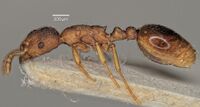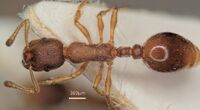Formicoxenus gebaueri
| Formicoxenus gebaueri | |
|---|---|

| |
| Scientific classification | |
| Kingdom: | Animalia |
| Phylum: | Arthropoda |
| Class: | Insecta |
| Order: | Hymenoptera |
| Family: | Formicidae |
| Subfamily: | Myrmicinae |
| Tribe: | Crematogastrini |
| Genus: | Formicoxenus |
| Species: | F. gebaueri |
| Binomial name | |
| Formicoxenus gebaueri Seifert, 2023 | |
The type sample was collected below a stone within a Picea-Pinus forest on a slope with rubble. The host species was an undescribed species of the Formica, subgenus Serviformica.
| At a Glance | • Xenobiotic |
Identification
Seifert (2023) - Worker. Numeric data given are arithmetic means based on measurement of 5 specimens (for standard deviation, minimum and maximum values see Tab. 1). Medium-sized, CS 738 µm. Head elongated, CL/CW 1.253. Genae in dorsal view nearly parallel. Median third of anterior margin of clypeus and hind margin of vertex in dorsal view straight. Frons narrower than in Formicoxenus sibiricus (FRS/CS 0.432), scape slightly shorter (SL/CS 0.712. Eye very small, EYE/CS 0.164. Dorsal profile of promesonotum and propodeum slightly convex, metanotal depression moderately deep (MGr/CS 2.95 %). Spines rather short and acute (SP/CS 0.153), their bases moderately distant (SPBA/CS 0.289). Petiole with strong anterolateral corners, in profile without peduncle and with a less broad subpetiolar lobe. Postpetiolar sternite with a welldeveloped spine. All surfaces of head, mesosoma, waist and appendages matt due to a reticulate microsculpture. Dorsal vertex strongly longitudinally carinulaterugulose. Gaster smooth and shiny but in contrast to F. sibiricus with subdecumbent to semierect setae. Head, mesosoma, waist, and gaster with long (PnHL/CS 0.128) setae, tapering apicad (Fig. 17) and round in cross-section. Color of head, mesosoma, waist and gaster homogenously yellowish brown.
As a combination of long, tapering setae, well-developed sculpture on head, mesosoma, waist and appendages and narrower frons, Formicoxenus gebaueri is unmistakable among the Palaearctic Formicoxenus species.
Keys including this Species
Distribution
Latitudinal Distribution Pattern
Latitudinal Range: 36.8° to 36.8°.
| North Temperate |
North Subtropical |
Tropical | South Subtropical |
South Temperate |
- Source: Seifert, 2023
Distribution based on Regional Taxon Lists
Palaearctic Region: China (type locality).
Distribution based on AntMaps
Distribution based on AntWeb specimens
Check data from AntWeb
Countries Occupied
| Number of countries occupied by this species based on AntWiki Regional Taxon Lists. In general, fewer countries occupied indicates a narrower range, while more countries indicates a more widespread species. |

|
Estimated Abundance
| Relative abundance based on number of AntMaps records per species (this species within the purple bar). Fewer records (to the left) indicates a less abundant/encountered species while more records (to the right) indicates more abundant/encountered species. |

|
Biology
Castes
Nomenclature
The following information is derived from Barry Bolton's Online Catalogue of the Ants of the World.
- gebaueri. Formicoxenus gebaueri Seifert, 2023: 137, figs. 14-17 (w.) CHINA.
Type Material
- Holotype and 7 paratype workers from the same nest labelled ‘CHINA: 36.82°N, 102.53°E, Beishan Nat. Park, 2600 m, Picea-Pinus-Wald, Geröllhang. A. Gebauer 1996.05.30’
Description
Seifert (2023) described this species using detailed morphometric data (see Table 1 of his study), as explained in his diagnosis of F. gebaueri (see the identification section on this species page) in comparison with other Palaearctic Leptothorax and Formicoxenus.
Etymology
Etymology: dedicated to the collector Axel Gebauer.

